
Many people with achy knees experience knee pain going down stairs. Often, descending the stairs hurts more than going back up.
Even worse, using the stairs isn’t optional. We need to navigate stairs to get into the house, to the bedroom or into the workplace.
In this article you’ll learn why you have knee pain going down stairs, the most common sources of knee pain, and the best strategies to dominate the staircase.
Why Does Going Down Hurt More?
Put simply, the knee can’t hide when we go down the stairs.
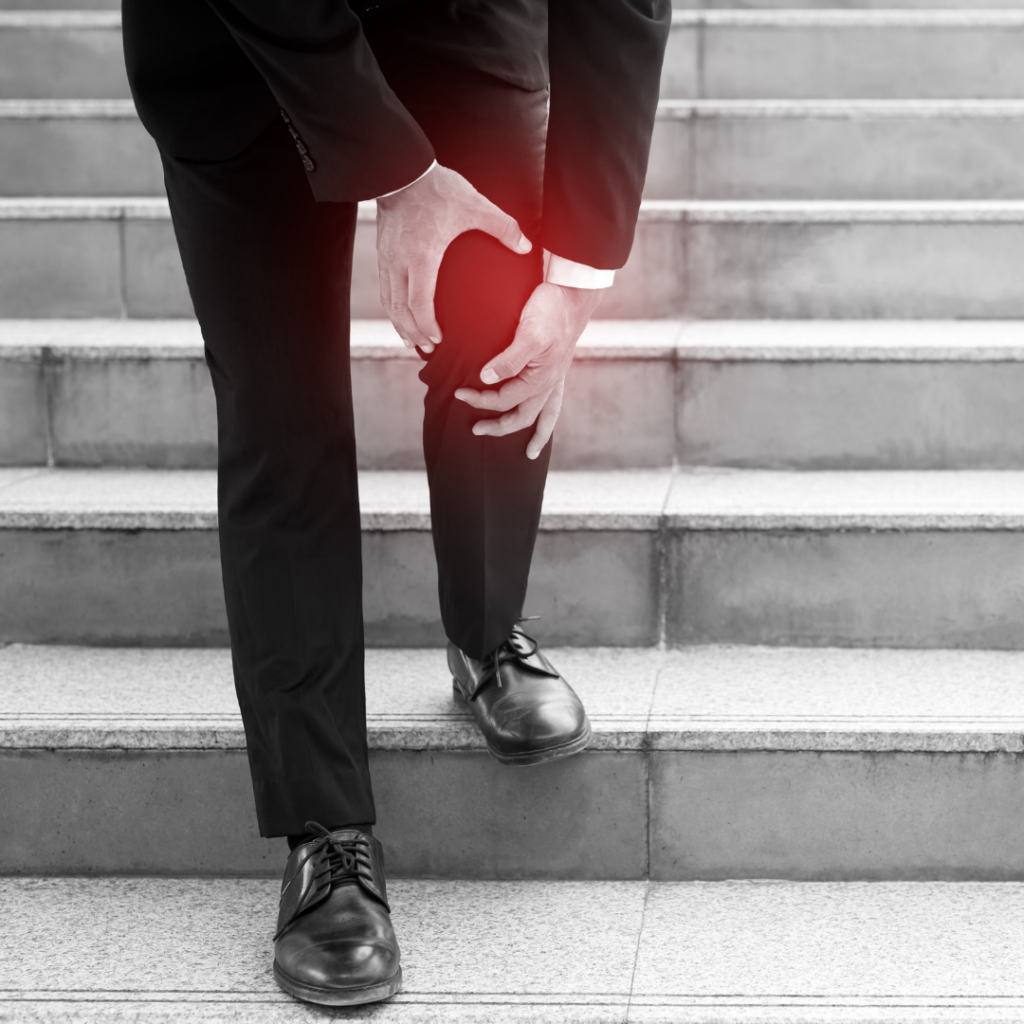
It’s easy to compensate for knee pain when going up stairs – the glutes, hamstrings and calf muscles can propel us up. But it’s much harder to compensate going down the stairs. So those irritable tissues in the knee handle the workload – and complain the whole way down.
Let’s take a quick look at the knee anatomy to understand common causes of knee pain.
Anatomy
The knee is a complex structure, but we’ll keep the anatomy review simple:
Joints
Two knee joints can hurt when going down stairs – the tibiofemoral joint and the patellofemoral joint.

The tibiofemoral joint is the knee joint you probably think of first; it’s where the tibia (shin bone) meets the femur (thigh bone).

The patellofemoral joint is the patella (kneecap) sitting on top of the femur.
Tibiofemoral Joint Pain
Knee osteoarthritis or joint irritation at the tibiofemoral joint causes stiffness with bending or straightening the knee. Swelling is common.
Swelling control, movement and strengthening the muscles around the joint is key. So is low-impact exercise like swimming, biking or using the elliptical.
Since we sit with our knees bent so often, stretching into knee extension (knee straightening) often loosens up the joint and reduces pain, even for people diagnosed with arthritis! (1)
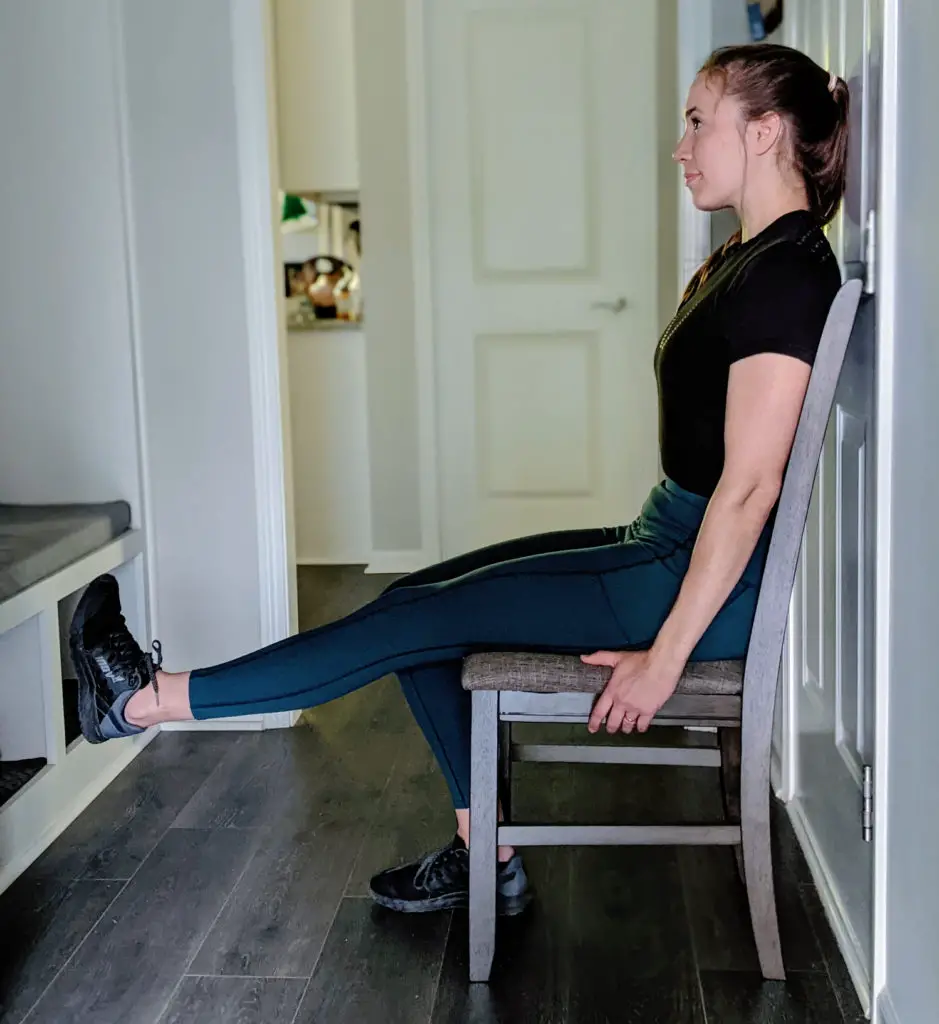
Long-term, a healthy body weight reduces the risk of knee osteoarthritis up to 78%! (2)
Patellofemoral Joint Pain
Pain behind the kneecap is called patellofemoral pain syndrome (PFPS). Pain occurs when the underside of the kneecap becomes irritated. It’s an overuse injury also known as runner’s knee and chondromalacia patellae.
Muscle weakness, especially in the quadriceps, puts you at greater risk for developing this common problem (3).
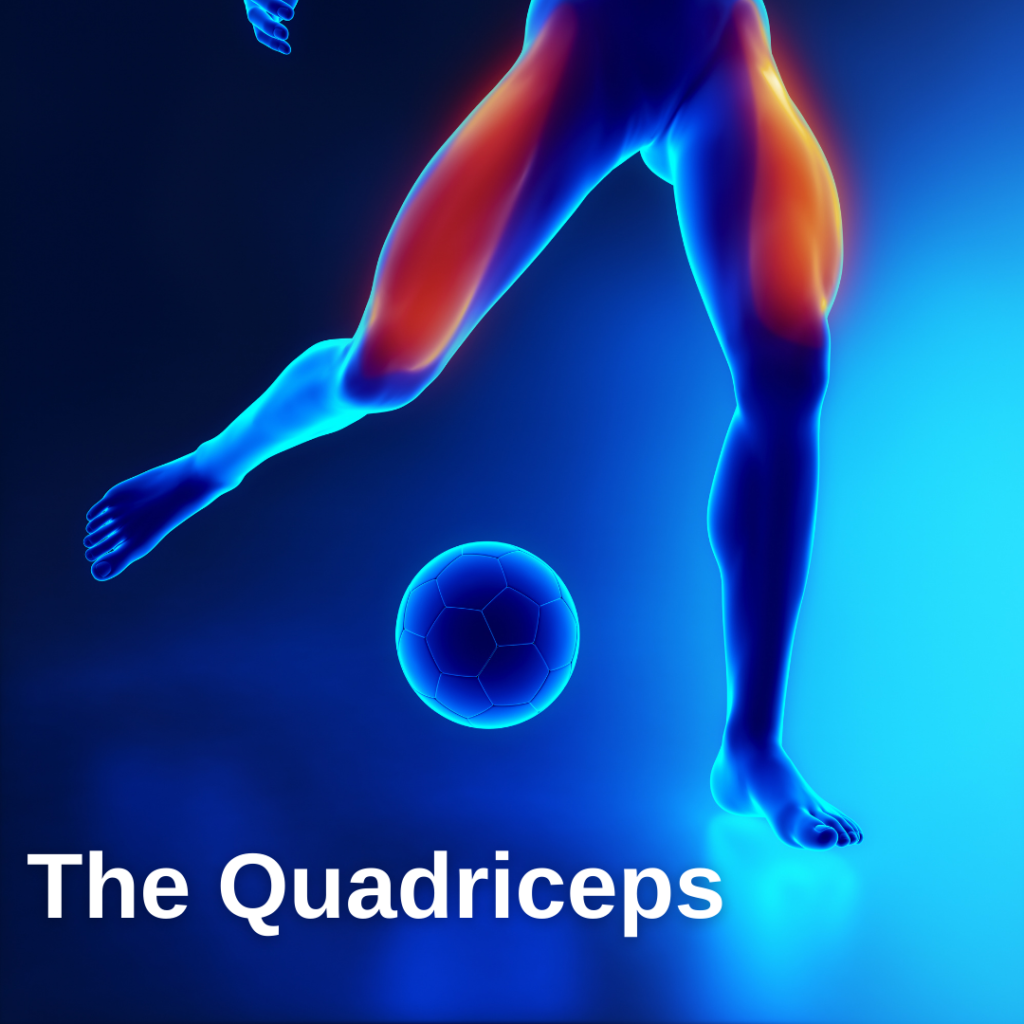
PFPS causes pain at the front of the knee. It hurts the most with deep knee bending, squatting, kneeling, and of course, going down stairs.
Patellofemoral pain gets aggravated with lots of repetitive knee movements. Strengthening the quadriceps and the glute muscles is key for alleviating and preventing this common cause of knee pain.
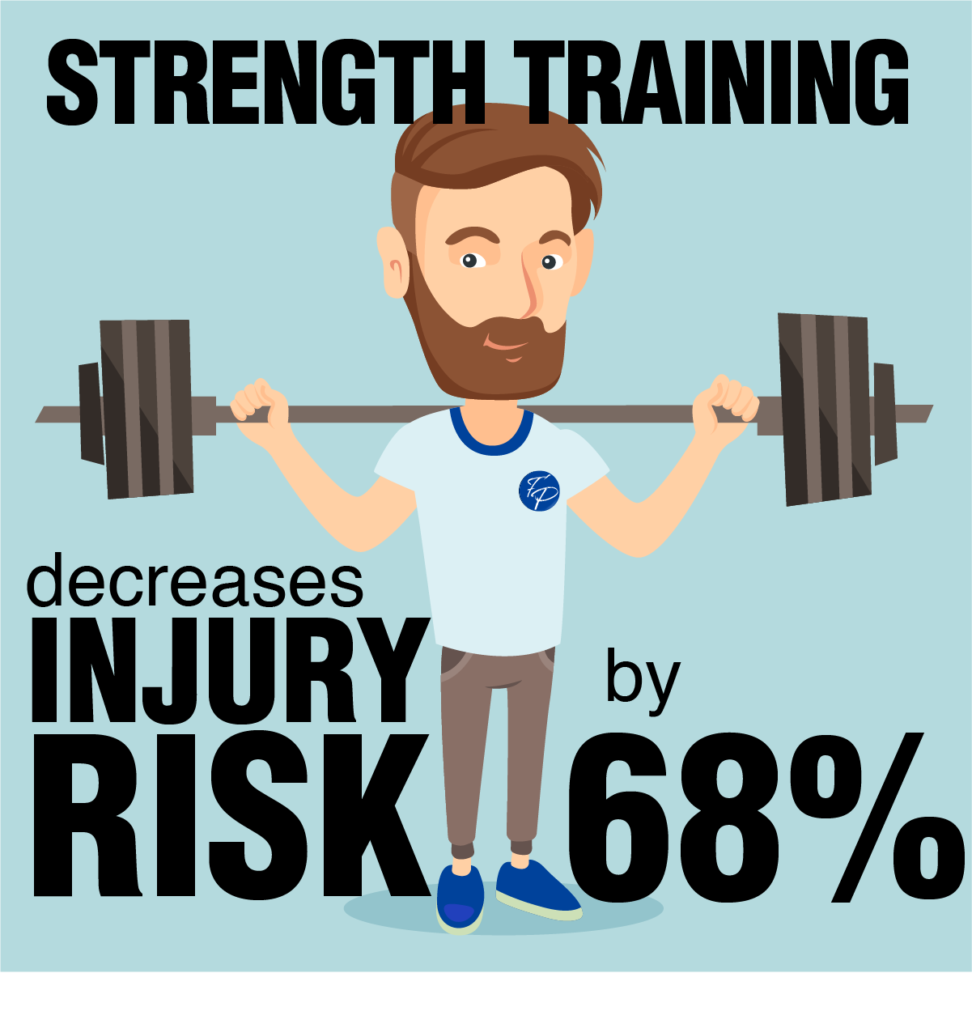
You’ll find several solid strengthening options towards the end of this article.
Soft Tissues
Soft tissue structures can also cause knee pain going down stairs. The IT Band and tendons attaching to the kneecap are frequent sources of pain.
IT Band Syndrome
IT band syndrome causes pain on the outside of the knee.

It’s caused by the IT band compressing a fat pad on the outside of the knee, just above the knee joints (4). Pain is worst with 30° of knee bending, which occurs with stair descent.
IT band treatment used to involve stretching and foam rolling the painful area, but those strategies are only effective for wasting time. It takes over a thousand pounds of force to stretch the IT band just 1%! (5)
Plus, foam rolling the IT band is about as pleasant as walking barefoot through a gravel parking lot.
Current guidelines for treating IT band syndrome recommend improving leg mechanics, modifying painful activities and strengthening the hip muscles (4).
Quadriceps Tendon and Patellar Tendon Pain
Tendon pain is another common cause of knee pain going down stairs. The tendons above and below the kneecap cause pinpoint anterior knee pain. Patellar tendon pain is often called jumper’s knee.
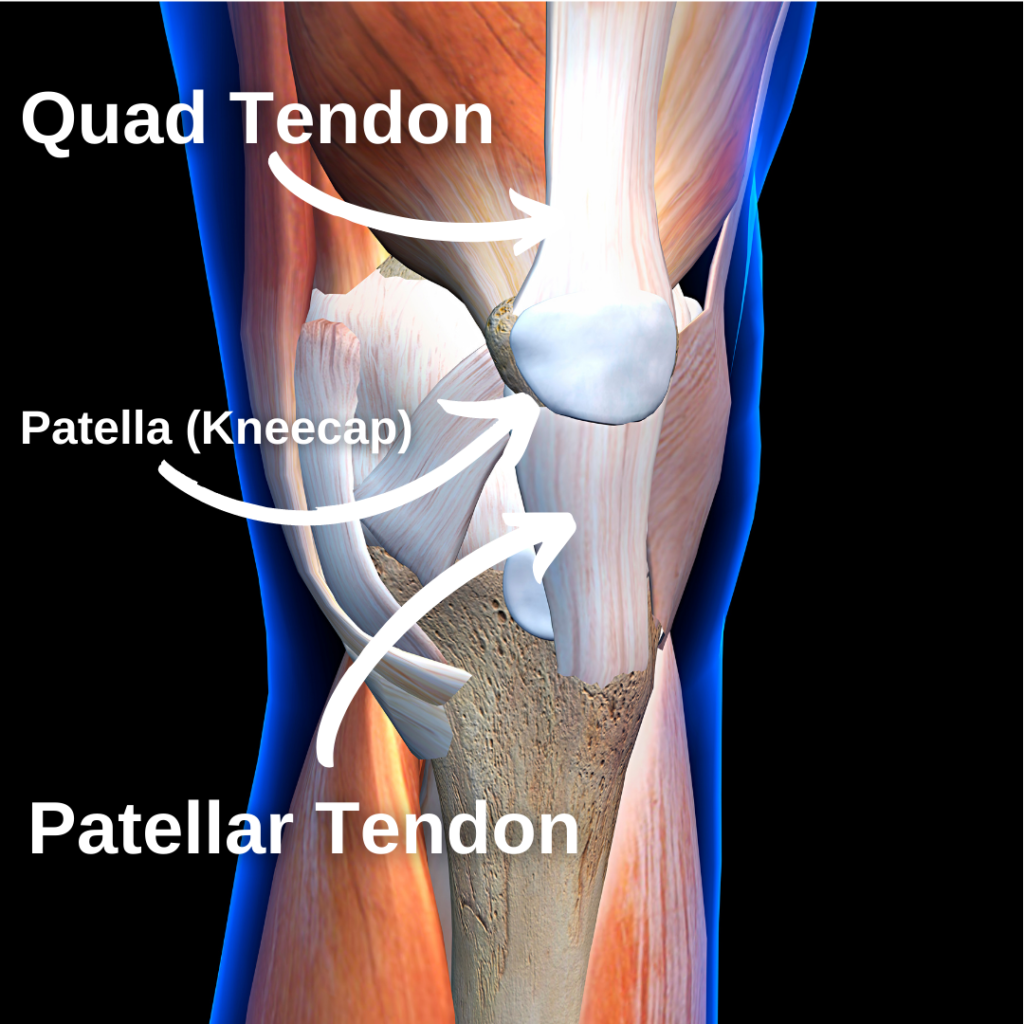
Tendon pain responds well to a progressive strengthening (6). Unlike some aches and pains, tendon issues don’t resolve with rest.
A tendon recovers with appropriate loading – not too much, not too little. Strengthening the tendon and surrounding muscles remodels the painful tissue, fortifying it to handle more activity in the future.
Lumbar Spine Referral
Finally, the low back refers pain to the knee often; it’s a relevant factor in knee pain over 1/4 of the time! (7)
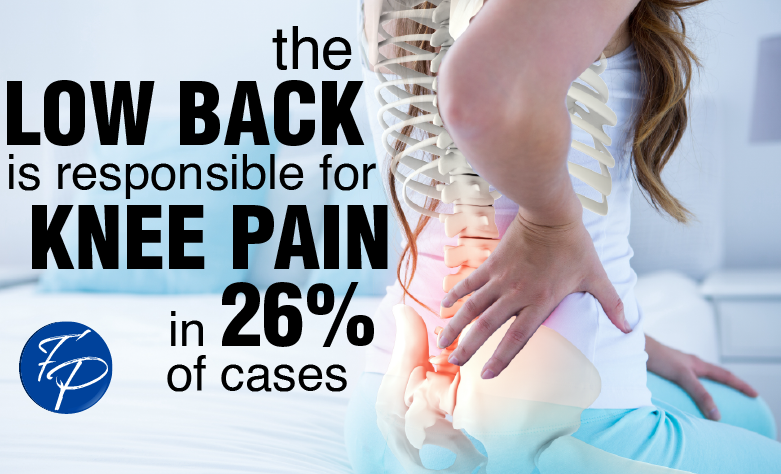
Screening the low back for involvement in knee pain is important, especially if symptoms change locations and seem unpredictable. To screen the low back, I use repeated movements for the lumbar spine.
Read more about repeated movements for low back pain here.
Treatment
As we’ve seen, quite a few structures can cause knee pain going down stairs. The good news is that treatment for different types of knee pain overlaps a lot.
Broadly speaking, every successful physical therapy treatment accomplishes one of two objectives:
- Reducing pain and irritation
- Building up strength and resilience
We’ll start with pain control strategies, then move to strengthening exercises.
Pain Control
Managing pain is the first step to recovery. We’ll cover 4 strategies to manage knee pain:
1) Stair Technique
If a patient’s knee is extremely irritable, I’ll teach them a different strategy to go down the stairs. I instruct them to go one step at a time, leading with the painful leg. It’s counterintuitive, but the lead leg works less going down the stairs. It’s opposite going up stairs; the lead leg works harder.
The phrase, “up with the good, down with the bad” describes the proper way to minimize pain going up and down the stairs. Step up with the “good” leg first, but lead with the “bad” (i.e. painful) leg going down.
It’s not a sexy option, but going backwards down the stairs is another proven strategy to reduce stress on the knee (8).
2) Swelling Control
Knee swelling indicates inflammation. Inflammation means the area is irritated. Reducing inflammation and swelling will reduce pain and let the knee move better.
Ice, compression and elevation are key to reducing knee swelling. Patients usually know to elevate and ice their knee, but compression is often forgotten. Compression is proven to enhance the benefits of icing for knee arthritis (9).
Compress your knee with a continuous knee brace like this one.
3) Taping
Taping is a proven pain relief technique (10) for patellofemoral pain syndrome (pain under the kneecap).

Check out this Runner’s Knee Taping article to learn how.
4) Bracing
Patellar bracing is another pain relief technique for patellar tendon pain. Tendon pain is localized to the tendon and feels worse with activity.
A patellar tendon brace dissipates the force through the tendon to reduce pain with activities like running, jumping and squatting. It’s a proven pain-relief strategy for patellar tendon pain (6). Check out this top-rated brace on Amazon.
Sadly, treatment often stops after pain is under control. But pain control is just the first step!
Strengthening Exercises
Strengthening the knee muscles and tendons reduces risk of re-injury and builds confidence to return to an active lifestyle.
Strengthening the quadriceps and glutes is recommended for just about every type of knee pain.

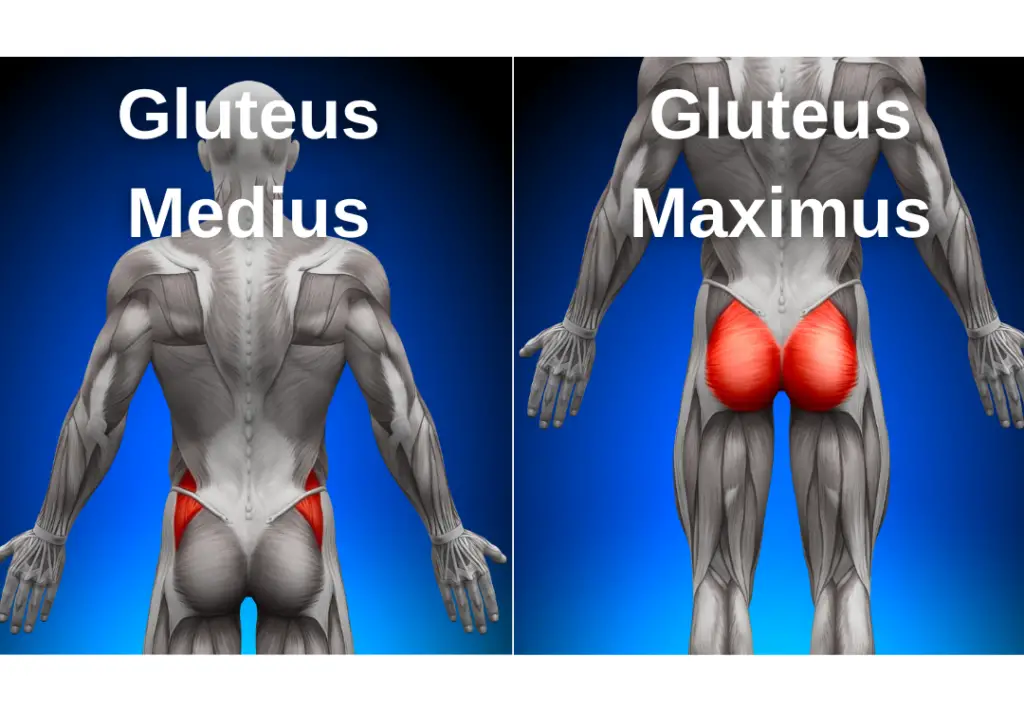
These 4 exercises target key leg muscles to make knee pain going down stairs a distant memory:
1) Long Arc Quads
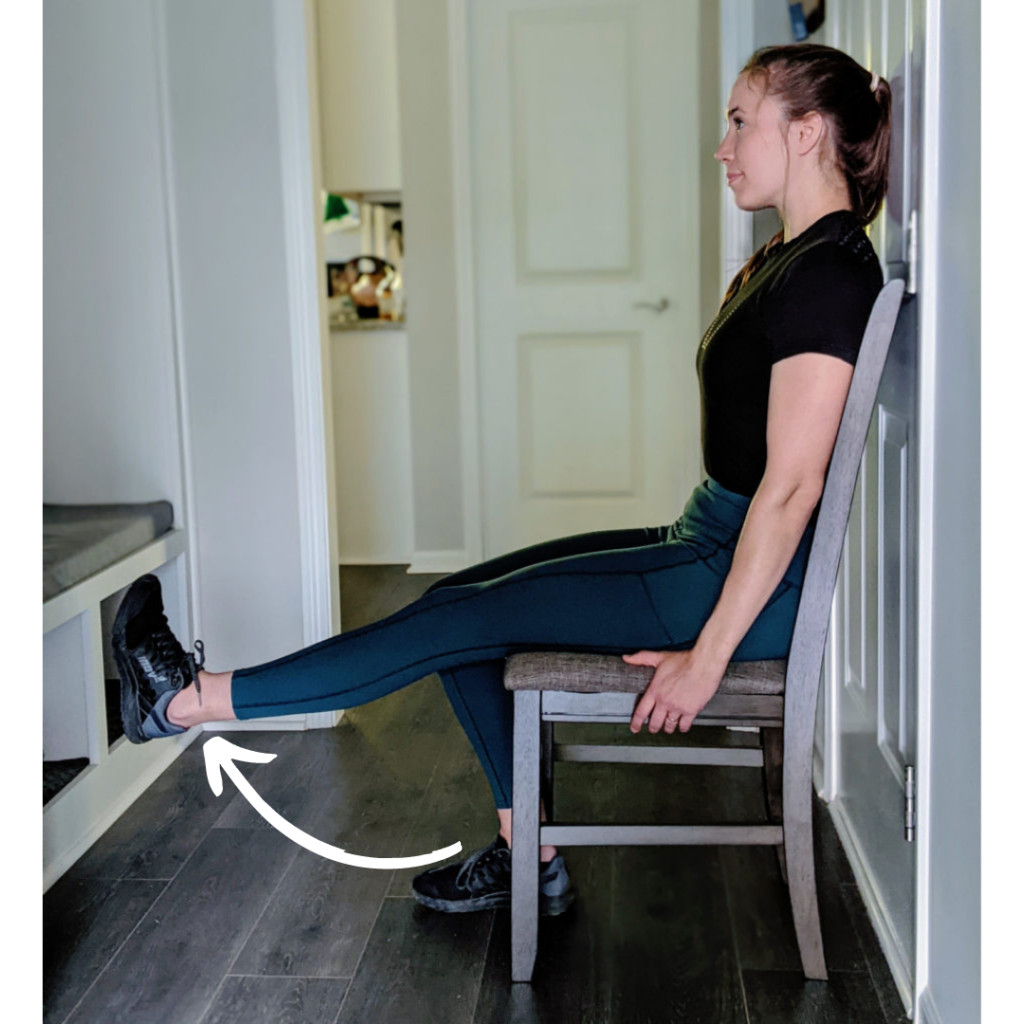
This simple exercise is a great way to get the knee moving and the quadriceps firing. It’s pain-free for most people with knee pain. Plus, it’s a great way to loosen up a knee that gets stiff with a lot of sitting.
2) Hip Burners
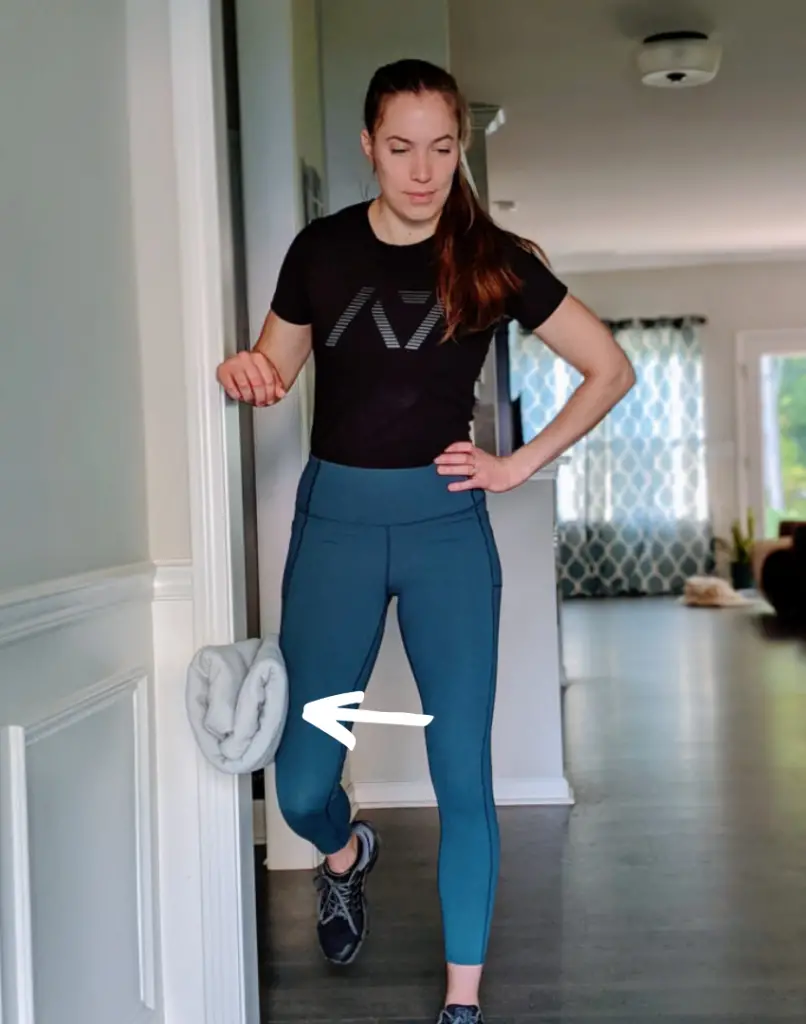
This isometric exercise torches the gluteus medius muscles and activates the quadriceps in a position that’s usually pain-free. I’ll be impressed if 10 repetitions of 5-second holds doesn’t set your glutes on fire!
3) Wall Sits
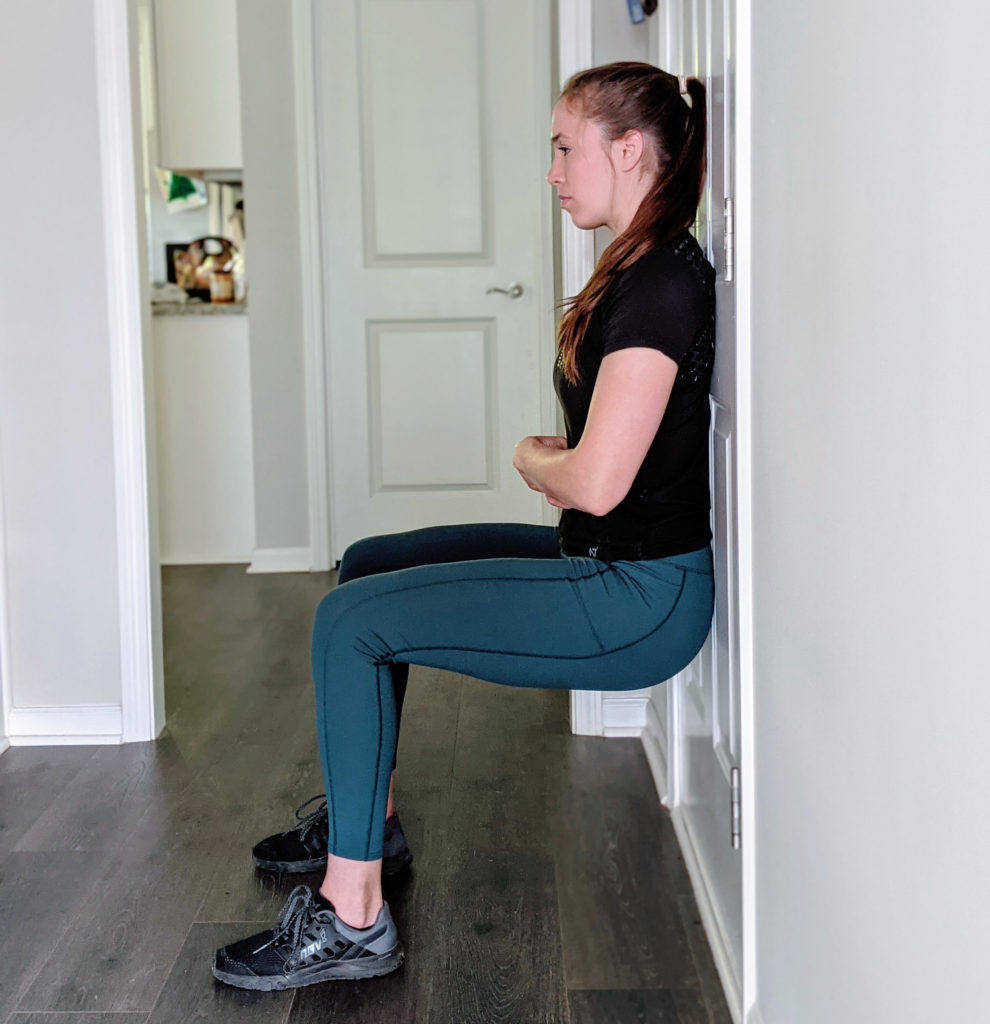
I hated wall sits during soccer practice. The muscle burning and shaking can be intense! These are great for quad strength. Start with the hips high. The lower you sit (like Liz in the picture), the harder it is.
Set a timer and hold the wall sit until you get tired. Over time, set a goal to hold longer or sit deeper into the wall sit.
4) Lateral Step Downs
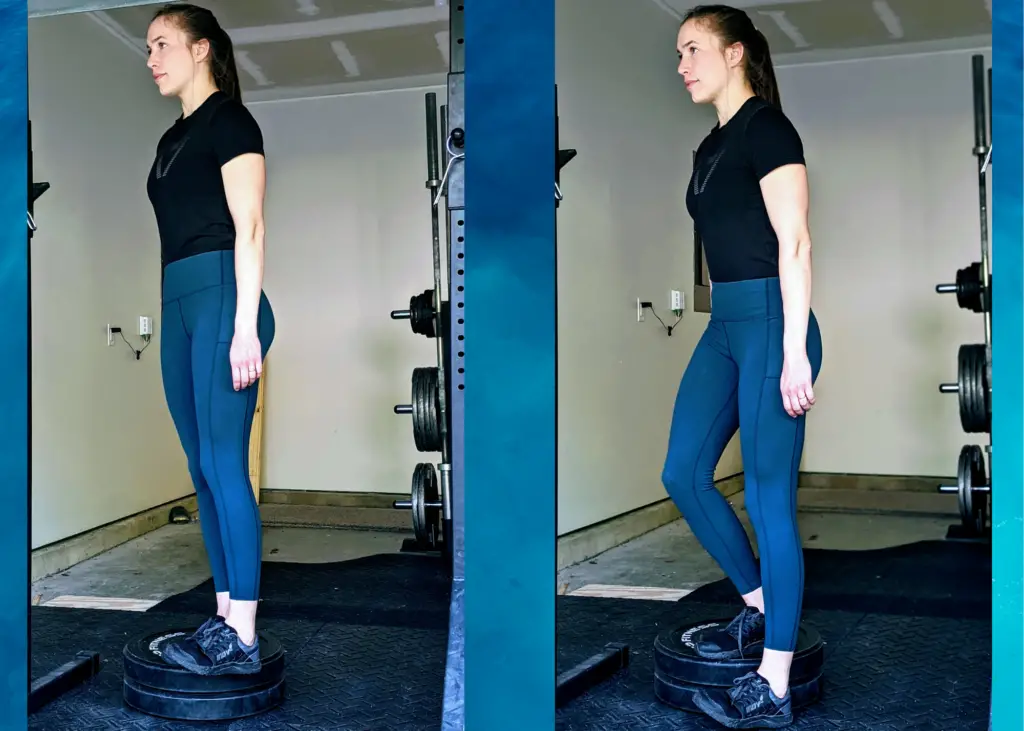
Step downs build confidence to descend the stairs. They also enhance quadriceps and glute strength. Plus, step downs transfer well to going down stairs since the movements are so similar.
Start with a small step. Bring the floor up to you with a book or few magazines if your stair is too high. A flight of stairs is about 12 steps. A few sets of 12 repetitions is a logical starting point if it’s pain-free.
The Next Step
If you’re interested in learning more about knee pain treatments, check out Treat Your Own Knee, a book that’s helped hundreds of people take control of their knee pain.
In most cases, conservative treatment alleviates knee pain going down stairs.
Working with a physical therapist is usually the best way to treat knee pain. PT’s know how to figure out why your knee hurts, develop an individualized treatment plan, and give you specific exercises to get your knee feeling better.
If you’ve dealt experienced knee pain going down stairs for a long time, do yourself a favor and schedule an appointment with your local physical therapist today.
For more evidence-based insights you won’t find anywhere else, join the free Facts & Physio Newsletter. Plus, get The Recovery Checklist e-book when you sign up.
References
- https://pubmed.ncbi.nlm.nih.gov
- https://bmjopen.bmj.com
- https://pubmed.ncbi.nlm.nih.gov
- https://meridian.allenpress.com
- https://pubmed.ncbi.nlm.nih.gov
- https://pubmed.ncbi.nlm.nih.gov
- https://www.tandfonline.com
- https://bmcsportsscimedrehabil.com
- https://www.ncbi.nlm.nih.gov
- https://www.ncbi.nlm.nih.gov


1 thought on “Knee Pain Going Down Stairs? Here’s Why (and The Best Way to Treat It)”
Clear, thorough and professionally presented. Thank you.